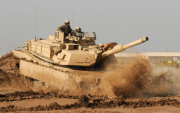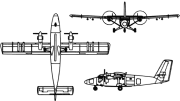|
That Works posted:Chances are that the majority of old diseases coming back around will not be well adapted to todays hosts / antibiotics etc and can get stomped out quick. Could be worse, could be a shape shifting alien that gets let loose.
|
|
|
|

|
| # ? May 24, 2024 22:58 |
Doctor Grape Ape posted:Could be worse, could be a shape shifting alien that gets let loose.
|
|
|
|
|
EvilMerlin posted:I don't think its going to be possible to pull another WW2 build out of the war machine. In any nation. Agree with this in part - you couldn't turn out today's weapons systems in quantity. The problem is that you're starting from the end of "could we mass produce 20,000 Abrams tanks in four years" instead of the end of "what would a full-scale wartime rearmament program look like." In a full-scale wartime rearmament program you are designing and building cheaper complimentary stuff that is suitable for mass producing using converted existing, or a combination of existing and newly developed assembly systems and processes.
|
|
|
|
Another question is whether the institutions and societies in place can withstand a peer-to peer war. Can a western 2019-government really stomach literally burning down entire BCTs without a massive upheaval and unrest? You have to remember that before “wartime industry” happens the war has already gone on long enough that such a revamp is needed. Closest example would propably be Iraq-Iran but neither of them at the time was really a western democracy.
|
|
|
|
the interdependent trade networks of Europe will never allow a war to go on for more than a year at most, we will never see another large European war like the franco-prussian war of 1870 Europe then proceeds to nail its own dick to the table twice in the next 70 years to be fair, the disruption in trade and losses did lead to the fall of several governments, but those new governments cheerfully took out the nine inch spike and rubber mallet twenty years later Smiling Jack fucked around with this message at 21:37 on Dec 16, 2019 |
|
|
|
|
I mean there's some truth to that, the central powers had to give up because they were starving.
|
|
|
Arglebargle III posted:I mean there's some truth to that, the central powers had to give up because they were starving. yeah I went back to edit that in but both Germany and Russia got stupid not bit twenty years later what with Finland and Poland and whoops here we go
|
|
|
|
|
Smiling Jack posted:yeah I went back to edit that in but both Germany and Russia got stupid not bit twenty years later what with Finland and Poland and whoops here we go Spain would like a world, please.
|
|
|
madeintaipei posted:Spain would like a world, please. About what, they were neutral in world war one and largely sat out world war two after a massively destructive civil war. my actual thesis, if I had to have one, is that the idea of "oh no we couldn't have a large war, it would be too disruptive and destructive" is largely contradicted by history.
|
|
|
|
|
Valtonen posted:Another question is whether the institutions and societies in place can withstand a peer-to peer war. Can a western 2019-government really stomach literally burning down entire BCTs without a massive upheaval and unrest? You have to remember that before “wartime industry” happens the war has already gone on long enough that such a revamp is needed. Has "oh poo poo these losses are horrendous, let's go off to the negotiating table" ever happened historically before the physical fighting capacity had also been eroded? The question in my mind really is more what do people settle on that usefully complements the nifty legacy stuff and also can be produced en masse.
|
|
|
|
Smiling Jack posted:About what, they were neutral in world war one and largely sat out world war two after a massively destructive civil war. Just teasing you  I think you are right on with your second point. Worse comes to worse in this world and I think we could all fight just fine with pick-em-ups, rifles, and barely trained infantry. Once the expensive assests are used up, and on a large enough front (or fronts), straight back to the meat-grinder. Yugoslavia, Congo War, Syria, all point to an endless capacity for violence, whatever the cost. A self-defeating machine, fed on blood, tears, and treasure. Hell on wheels.
|
|
|
|
aphid_licker posted:Has "oh poo poo these losses are horrendous, let's go off to the negotiating table" ever happened historically before the physical fighting capacity had also been eroded? The question in my mind really is more what do people settle on that usefully complements the nifty legacy stuff and also can be produced en masse. France 1916, Russia 1917. Now as you said it was -after- they also had massive losses so yes it’s apples and oranges. However, another difference is how a modern war will affect civilian population: internet, freedom of travel and speech, exports disappearing from markets or price going up exorbitantly. Hell, GPS satellites going dark or getting priorized to military only and google maps disappearing will be a major pain. I’m sure they said the same at 1910s and 1930s, but the concept of “nation in war footing” is really hard to take without waiting to see governments get toppled/backed by martial law.
|
|
|
|
Valtonen posted:France 1916, Russia 1917. Now as you said it was -after- they also had massive losses so yes it’s apples and oranges. However, another difference is how a modern war will affect civilian population: internet, freedom of travel and speech, exports disappearing from markets or price going up exorbitantly. Hell, GPS satellites going dark or getting priorized to military only and google maps disappearing will be a major pain. I think there's probably a minimum time that's dependent on human psychology before it sinks in that what's happening is unsustainable and needs to be stopped even if you lose face / have to change what you're doing.
|
|
|
|
aphid_licker posted:I think there's probably a minimum time that's dependent on human psychology before it sinks in that what's happening is unsustainable and needs to be stopped even if you lose face / have to change what you're doing. Judging from the "reaction" to the climate crisis in the various governments of the world, that minimum time appears to be at least 50 years and counting.
|
|
|
|
Cyrano4747 posted:I suspect that the idea is that it's easily blocked by different people. China has some poo poo with the US and Canada, but they also aren't likely to blockade traffic going from there to Europe. In a world where that's happening we're deep into international tensions so hosed that pretty much any route is vulnerable. Transpacific direct LA/LB, rail to US East Coast, transatlantic direct Northern Europe Northern Europe via Panama Northern Europe via Cape Horn These are all simpler and likely cheaper than the NSR or NWP. Baring a significant increase in daily charter rate or an even more significant decrease in ice navigation premiums. (But really at current BDI rates, nobody’s gonna go north to save a couple days.)
|
|
|
|
So why was the Russian navy parking a decommissioned sub in a decommissioned floating dock in the middle of a relatively valuable naval base? Surely there are better places to store something that size.
|
|
|
|
Godholio posted:So why was the Russian navy parking a decommissioned sub in a decommissioned floating dock in the middle of a relatively valuable naval base? Surely there are better places to store something that size. Yeah, next to the Kursk.
|
|
|
|
Godholio posted:So why was the Russian navy parking a decommissioned sub in a decommissioned floating dock in the middle of a relatively valuable naval base? Surely there are better places to store something that size. They’re annoying to move though. Also, Russia.
|
|
|
|
The post soviet Russian navy got hit hard by budgetary shortfalls and general neglect. They had major warships rotting at the piers. I can easily see how a couple of lesser vessels would just get ignored until they sank. Edit:b they’re better about it now than in the mid 90s but there’s still a lot of poo poo that hasn’t been properly maintained in almost 30 years.
|
|
|
|
Sadly I wonder what they were doing with the tango class, scrapping or trying to refurbish it?
|
|
|
|
That Works posted:Chances are that the majority of old diseases coming back around will not be well adapted to todays hosts / antibiotics etc and can get stomped out quick. This is quite true, and I would recommend people do like me (at least if they plan on going out in nature or also have a career there) and stay abreast of new strains instead. Somehow, we just got a new brand of tick-borne brain bug here in Denmark that is native to Russia, and of course it hangs out in one of my favorite forestst, so I got the vaccine. I mean, sure, it's a fair spot of money for something that might never be activated, but considering how badly it fries the brain I'm not taking any loving chances. Plus, with climate change growing it may offer resistance to some of this bad boys mutated strains in the future
|
|
|
|
aphid_licker posted:Has "oh poo poo these losses are horrendous, let's go off to the negotiating table" ever happened historically before the physical fighting capacity had also been eroded? Back in the 50s there was talk of broken-back war, the recognition of the fact that even after all of the initial fighting ground down due to lack of munitions and replacements the war would probably continue. Cessna fucked around with this message at 15:42 on Dec 18, 2019 |
|
|
|
We're so painfully dumb as a species Underwater dieselelectric drone!: https://twitter.com/CovertShores/status/1206931639739330560
|
|
|
aphid_licker posted:We're so painfully dumb as a species Waiting for the autonomous wind-powered drone
|
|
|
|
|
That Works posted:Waiting for the autonomous wind-powered drone https://www.saildrone.com Those things are actually super impressive.
|
|
|
|
aphid_licker posted:We're so painfully dumb as a species Fisheries enforcement drone sub, 2030
|
|
|
|
EvilMerlin posted:In today's world? It’s a very labor intensive industry not well suited to automation and involves a huge downstream supply chain as far as engines etc, which is why a big reason why developing industrial nations have historically subsidized it to develop an industrial base. That’s led to huge oversupply, and the closure of higher cost western yards, except those doing specialized defense/luxury work. Japanese and American yards put all the European yards out of work in the post war period, then in the past 30 yrs the Koreans undercut the Japanese and Americans, and now the Chinese and Vietnamese are undercutting everyone.
|
|
|
|
Kaiser Schnitzel posted:Shipbuilding is a pretty huge industrial sector as well that the west has mostly abandoned to East Asia and recently especially China. There’s maybe half a dozen yards still around the US that build large Navy vessels and a few smaller ones that build oil and gas/commercial stuff that must be made domestically per the Jones act. Scaling up capacity and a skilled labor force to start replacing the massive losses to commercial (not to mention military) shipping a large scale war would involve would be very hard to mobilize for. Maaaybe/hopefully the core of maybe 50-100,000 shipbuilders still employed in the US are enough of a nucleus to rebuild the industry off of, but man would we need a bunch more welders. There’s only one yard (Newport News)that can build carriers and it takes a decade for each one, and IIRC only one yard (Ingalls) that can handle the smaller LHA/LHD stuff too. Yep. There used to be major ship building facilities in nearly every major blue water port in the US...
|
|
|
|
Is there a single ship building facility in the world that would be able to survive the opening weeks of any peer conflict? Even one that is purely conventional? The kind of ship building effort that occurred during WW2 seems to me almost impossible to replicate under the constant threat of modern stand off weapons.
|
|
|
|
Ice Fist posted:Is there a single ship building facility in the world that would be able to survive the opening weeks of any peer conflict? Even one that is purely conventional? What would a non nuclear peer conflict involving continental US shipyards being destroyed look like? Seriously, I have no idea how it could happen without nukes flying.
|
|
|
|
Sub launched cruise missiles? I know we have a lead on the intelligent cruise missile thing but russian had a huge lead on us on antiship missiles for the longest time and im assuming either russia or china at minimum has beem able to make a cruise missile that can seaskim and hit the naval yards from 100km offshore. Or launching their normal antiship cruise missiles (if they're sub launchable)and hoping that doing significant damage to a hull in production messes up the yards themselves. That sub would probably be dead soon after but wouldnt you trade a sub and 100 sailors for taking out the only yard capable of building replacement carriers for the united states navy? Edit: i dont know how a conflict against a nation large enough to pull it off would stay nonnuclear either its just the only way i can think of it happening in a conventional war. Im assuming the sea access to those yards is as tightly controlled as airspace at nellis or SAC hq so a speedboat with an asston of explosives wouldnt be able to suicide charge into them Stravag fucked around with this message at 21:16 on Dec 17, 2019 |
|
|
hobbesmaster posted:What would a non nuclear peer conflict involving continental US shipyards being destroyed look like? Yeah same. I'm trying to imagine Avondale shipyard in the middle of New Orleans getting hit by airstrikes or something and I don't see how that happens without something else turning into radioactive ash.
|
|
|
|
|
Stravag posted:Sub launched cruise missiles? I know we have a lead on the intelligent cruise missile thing but russian had a huge lead on us on antiship missiles for the longest time and im assuming either russia or china at minimum has beem able to make a cruise missile that can seaskim and hit the naval yards from 100km offshore. Or launching their normal antiship cruise missiles (if they're sub launchable)and hoping that doing significant damage to a hull in production messes up the yards themselves. That sub would probably be dead soon after but wouldnt you trade a sub and 100 sailors for taking out the only yard capable of building replacement carriers for the united states navy? I don't think a speedboat with an asston of explosives would actually do all that much damage to a major shipyard. It could so some local damage, sure but those facilities are huge. Likewise for a single cruise missile. If you could dump an entire SSGN's worth of cruies missiles into such a facility then you'd be on to something.
|
|
|
|
Stravag posted:
You could pretty much ride a fishing boat right up to Ingalls, at least a few years ago. Don’t know about Newport News, but I’d assume security is a bit tighter. Is a fishing boat full of explosives going to do much damage to a huge concrete pier/dry dock? Probably not.
|
|
|
|
If we would end the world over a Chinese Dolittle Raid, we probably should give up in the western Pacific now. There is no way a conventional conflict doesn't involve targets on the Chinese mainland, and I'd think we should expect turnabout.
|
|
|
|
Captain von Trapp posted:If we would end the world over a Chinese Dolittle Raid, we probably should give up in the western Pacific now. There is no way a conventional conflict doesn't involve targets on the Chinese mainland, and I'd think we should expect turnabout. China's strict No First Use policy says otherwise.
|
|
|
|
Click denier from the sad, failing NYT: The day all pigs would diequote:WULONGQIAO, China — A devastating disease spreading from China has wiped out roughly one-quarter of the world’s pigs, reshaping farming and hitting the diets and pocketbooks of consumers around the globe.
|
|
|
|
Isn't swine the biggest mixer for diseases jumping to humans? I thought diseases in pigs are potentially plague starting.
|
|
|
|
There have been a bunch of visitors turning up to airports in Australia carrying pork products recently. The punishment for that is pretty light. You get the gently caress out and you don't get to come back.
|
|
|
|

|
| # ? May 24, 2024 22:58 |
Captain Log posted:Isn't swine the biggest mixer for diseases jumping to humans? I thought diseases in pigs are potentially plague starting. Them and birds but for flu virus mostly. Those happen but sporadically. The bigger constant societal danger is using antibiotics 24/7 on those animal farms.
|
|
|
|











































